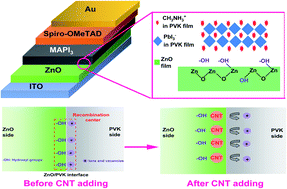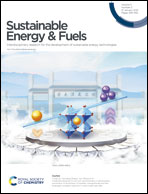Surface treatment of ZnO films with carbon nanotubes for efficient and stable perovskite solar cells†
Abstract
Organohalide lead perovskites (PVKs) are among the leading materials for the fabrication of high-efficiency and low-cost photovoltaic devices. Deposition of a suitable electron transport layer (ETL) plays a pivotal role in the manufacturing of perovskite solar cells (PSCs). Among all reported ETLs, zinc oxide (ZnO) has not been developed properly compared with its counterparts such as TiO2 and SnO2. In this work, we fabricated PSCs based on low-temperature solution-processed ZnO nanoparticles under ambient conditions. The degradation of PVK films on the ZnO ETL has been widely reported in the literature. We demonstrate that the localization of positive ions resulting from hydroxyl groups (–OH) present at the ZnO surface is a reason for this issue. In order to deactivate these groups, we treated the surface of the ZnO ETL with carbon nanotubes (CNTs) before the deposition of the PVK film. We found that CNTs modify the ZnO surface and stop the potential reaction between the ZnO and PVK films. The results demonstrate that the CNT modification of ZnO resulted in a PVK film with larger grains without any pinholes. Upon incorporation of CNTs into our devices, we improved the power conversion efficiency of the PSC from 15.05% to 18.79%, possibly due to the higher quality of the PVK film and improved charge extraction properties. Most importantly, PSCs based on the ZnO/CNT ETL showed better ambient and thermal stability compared to the reference PSCs.

- This article is part of the themed collection: Organic Materials for Energy Conversion and Storage


 Please wait while we load your content...
Please wait while we load your content...